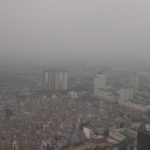Incense burning has become an integral part of East Asian culture, especially in Vietnamese families with a belief in worshipping ancestors and deities. However, the smoke produced from burning incense can have certain health implications, particularly for young children.
1 Impact of Incense Smoke on Children’s Health
Fine Dust Pollution
Fine dust pollution is an issue of growing concern, as it is not just an outdoor problem but also prevalent indoors, posing a high risk of air pollution.
Sources of indoor air pollution include cooking fumes, tobacco smoke, and incense smoke, all of which can adversely affect respiratory health at any age.
Increased Emissions
Burning incense in enclosed, narrow spaces can lead to increased emissions, mainly carbon monoxide (CO). Inhaling CO can cause headaches, difficulty breathing, chest pain, and dizziness.
 Impact of Incense Smoke on Children’s Health
Impact of Incense Smoke on Children’s Health
Effects on Respiratory System
The impact of incense smoke on health is similar to that of cigarette smoke. Prolonged exposure to incense smoke can increase the risk of respiratory diseases and exacerbate existing conditions.
Additionally, some other potential effects of incense smoke on children include an increased risk of nasal and throat cancer, contact dermatitis, asthma, coughing, and developmental delays.
2 Ways to Minimize the Harmful Effects of Incense Smoke on Children’s Health
- Refrain from burning incense when infants, young children, the elderly, or individuals with respiratory conditions are present in the room.
- Opt for higher-quality incense sticks that produce minimal or no smoke.
- Ensure proper ventilation by opening windows, turning on exhaust fans, or using a range hood when burning incense.
- Designate a separate room for worship, preferably away from the children’s play and living areas.
- Avoid lighting multiple incense sticks simultaneously or doing so continuously.
 Ways to Minimize the Harmful Effects of Incense Smoke
Ways to Minimize the Harmful Effects of Incense Smoke
This article has provided insights into the impact of incense smoke on children’s health and suggested ways to mitigate its harmful effects. By being mindful of these risks and taking preventive measures, parents can better safeguard their children’s well-being.
Source: Helino
Helping Young Kids Sleep Comfortably with 7 Strategies for Using Air Conditioning
Having trouble figuring out the best way to use an air conditioner around your kids? Fear not – these tips can help make sure your children remain safe and comfortable while under an air conditioner. Read on for more information and advice on how to use air conditioners correctly with your children.






































